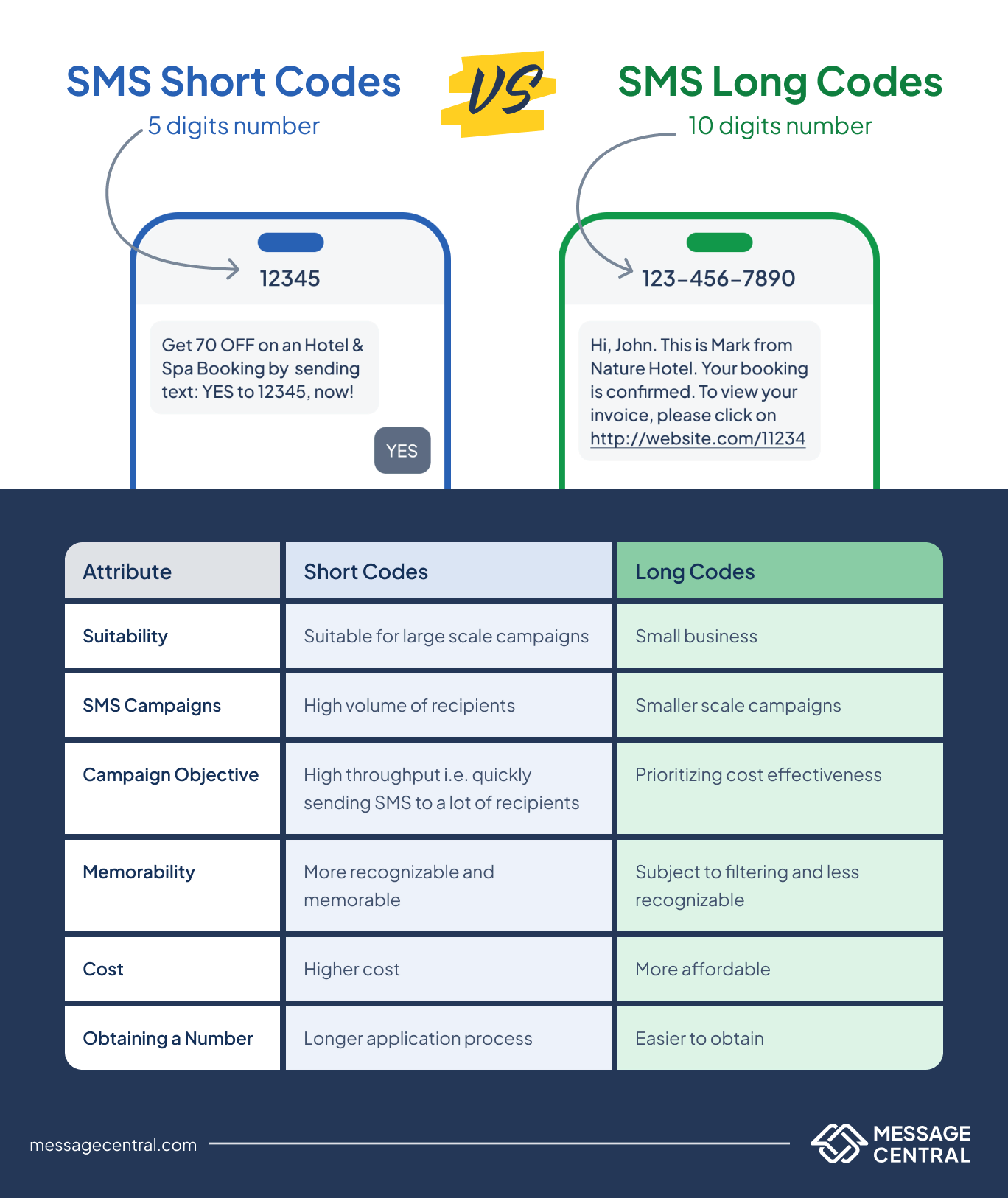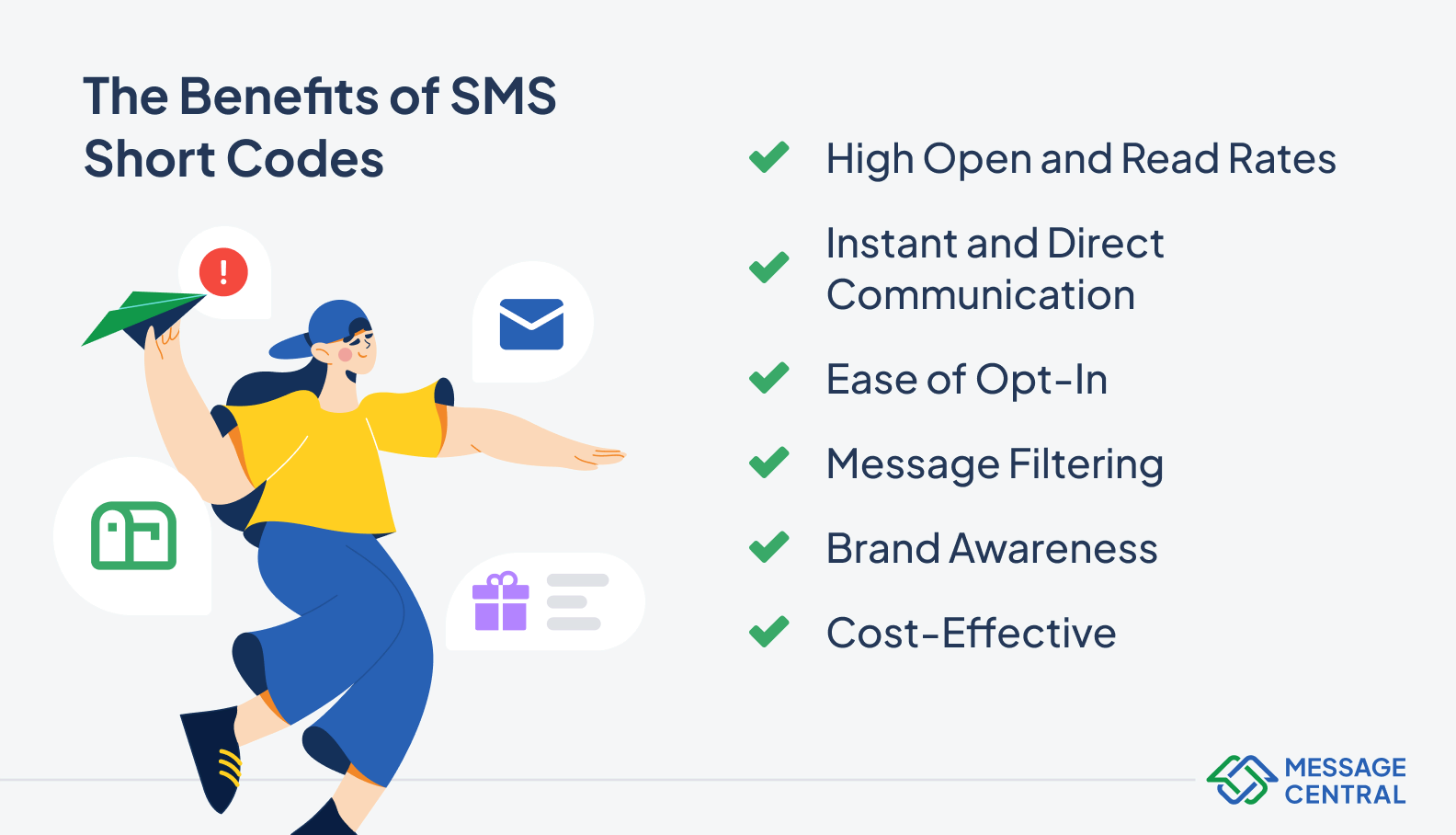Key Takeaways
- SMS short codes are five or six digot phone numbers which are used for multiple use cases like SMS marketing campaigns
- These codes make it easier for businesses to reach their users on SMS by establishing a direct line of communication
- There are different types of SMS short codes like dedicated short codes, toll-free numbers and 10DLC numbers
- You can get an SMS short code by applying to the concerned authority like the US short code administration
- There are multiple benefits of SMS short codes like message filtering, brand awareness, cost effectivity etc.
SMS advertising with a CAGR of 1.95% is estimated to reach a market volume of US $0.79 billion in 2024. One key element of SMS advertising is the use of SMS code numbers, also known as short codes. These are used for the purposes of SMS marketing, transactional notifications, and OTP verification.
In this guide, we will explore what SMS code numbers are, their benefits, best practices for using them, and alternatives to consider.
What are SMS Short Codes?
SMS short codes are five- or six-digit phone numbers used for SMS marketing campaigns or other use cases like OTP SMS. They provide a quick and convenient way for businesses to communicate with their audience via text messages or text blasts which are sent by businesses to reach their users. Short codes are typically paired with a keyword, which allows users to opt in to receive messages from a specific campaign or organization.
For example, a clothing brand might ask customers to text the keyword "FASHION" to a short code number to receive updates on the latest trends and offers.
SMS code numbers have become increasingly relevant in the marketing landscape, especially as the use of third-party cookies is being phased out. With high open rates and immediate reach, SMS code numbers offer businesses a direct line of communication with their audience. Businesses are also experimenting with other direct channels of communication like WhatsApp, RCS etc. RCS vs SMS debate has been doing rounds for quite some time now.
Types of SMS Short Codes
There are different types of SMS code numbers available for businesses to choose from. The three main types are dedicated short codes, toll-free numbers, and 10DLC numbers. Each type offers unique features and considerations.
- Dedicated Short Codes
Dedicated short codes are leased by a single brand or organization, ensuring exclusive use. Shared short codes, which were previously available, have been phased out by phone providers. Vanity short codes, a type of dedicated short code, allow businesses to select a specific number that is easier for consumers to remember. - Toll-Free Numbers
Toll-free numbers are familiar to most people, often starting with the prefix 1-800. These numbers are traditionally used for phone calls but can also be used for SMS marketing campaigns. However, it's important to note that toll-free numbers do not support MMS (Multimedia Messaging Service), limiting the types of messages that can be sent. - 10DLC Numbers
10DLC (10-Digit Long Code) numbers are a newer option that provides an alternative to short codes. These numbers consist of 10 digits and are often used by small and medium-sized businesses. A2P 10DLC numbers offer a more cost-effective solution compared to short codes and can be registered in a shorter timeframe.
How to Obtain an SMS Short Code
To obtain an SMS code number, businesses must apply to lease a short code from the appropriate governing body, such as the US Short Code Administration. The application process typically involves providing information about how the short code will be used and what types of messages will be sent.
Alternatively, businesses can work with an SMS API provider or aggregator like Message Central to acquire a short code on their behalf. These providers are well-versed in the application process and can guide businesses through the necessary steps.
It's important to note that obtaining a short code can involve an approval process, which may take several weeks. Businesses should plan ahead and consider the timeframe when incorporating SMS code numbers or short codes into their marketing strategy.
SMS Short Codes vs SMS Long Codes

The Benefits of SMS Short Codes

SMS code numbers offer several benefits for businesses and organizations looking to engage their audience effectively. Here are some key advantages:
- High Open and Read Rates: SMS messages have an average open rate of 98%, making them one of the most effective communication channels. Additionally, messages are typically read within minutes of being received, ensuring timely delivery of important information.
- Instant and Direct Communication: SMS code numbers allow businesses to reach their audience instantly and directly. These can also be forwarded. You can also read our guide on how to forward a text.
- Ease of Opt-In: Short codes provide a simple and convenient way for users to opt in to receive messages from a specific campaign or organization. By texting a keyword to a short code number, users can easily subscribe to updates and offers.
- Message Filtering: Unlike other types of phone numbers, SMS code numbers are not subject to message filtering. Every code and sender is manually vetted by wireless carriers, ensuring that messages are delivered without interference.
This can be really helpful in time sensitive campaigns. For example: A2P SMS for political campaigns. - Brand Awareness: Short codes, especially vanity codes, allow businesses to create a memorable and recognizable brand presence. When users receive messages from a familiar short code number, it helps build brand awareness and trust.
- Cost-Effective: SMS code numbers offer a cost-effective solution for businesses to reach their audience at scale. With the ability to send messages quickly and at a low cost, businesses can engage with hundreds or thousands of recipients efficiently. For example, abandoned cart SMS notifications.
Best Practices for Using SMS Code Numbers
To make the most of SMS code numbers in your marketing campaigns, it's important to follow best practices. Here are some tips to consider:
- Adhere to Short Code Compliance Rules: Familiarize yourself with the rules and regulations governing the use of short codes. Ensure that your messages comply with all applicable laws and guidelines to avoid any legal issues.
- Advertise Your Short Code Number: Promote your short code number across various channels to encourage opt-ins. Use signage, social media, websites, and other marketing materials to raise awareness of your SMS marketing campaigns.
- Use Keywords to Track Campaigns: Assign unique keywords to different campaigns or offers to track their performance. This allows you to gauge the effectiveness of each campaign and tailor future messages accordingly. You can also do it using the SMS dashboard provided by your SMS API provider.
- Choose a Memorable Vanity Short Code: If possible, select a vanity short code that is easy for consumers to remember. A catchy and memorable short code can increase engagement and response rates.
- Use it to Send High-Volume, Time-Limited Messages: Leverage your short code to send time-sensitive messages or limited-time offers. The urgency created by these messages can drive immediate action from your audience.
- Improve Customer Service: Use your short code to provide customer support and address inquiries or issues. SMS can be a convenient and efficient channel for customers to communicate with your business.
- Nail Your SMS Cadence: Find the right balance in the frequency of your SMS messages. Avoid overwhelming your audience with too many messages, but also ensure that you are sending enough to keep them engaged and informed using cascading messaging.
- Leverage SMS Automation: Take advantage of automation tools to streamline your SMS marketing campaigns. Set up automated workflows and triggers to deliver personalized messages at the right time, enhancing the overall customer experience.
FAQs
Q1: Do SMS code numbers work in other countries?
SMS code numbers are country-specific, and the availability and regulations may vary. If you plan to send SMS messages internationally, it's essential to research the specific requirements and restrictions for each country. Your SMS provider like Message Central can also help you in this regard.
Q2: Who can obtain an SMS code number or an SMS short code?
SMS code numbers are typically obtained by businesses and organizations that have a legitimate need for SMS marketing. The application process may involve providing information about your business, intended use of the code, and compliance with relevant regulations.
Q3: How do users opt in and out?
Users can opt in to receive messages from a specific SMS code number by texting a keyword to the code. Opting out is usually as simple as replying with a specific keyword, such as "STOP" or "UNSUBSCRIBE," which instructs the system to remove the user from the subscription list.
Get Started with SMS Marketing with Message Now
Message Now is an SMS API provider by Message Central. The platform provides: -
- Global connectivity
- The best SMS routes
- Competitive SMS rates
- 24/7 customer support
- Analysis and dashboard
You can get in touch with the team or signup for free to try SMS APIs.








